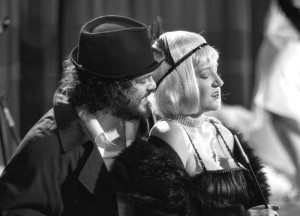 [The Staxx Brothers will appear at East Portland’s Mt. Tabor Theater on March 16, and at the Hard Rock Cafe in Seattle on St. Patrick’s Day.]
[The Staxx Brothers will appear at East Portland’s Mt. Tabor Theater on March 16, and at the Hard Rock Cafe in Seattle on St. Patrick’s Day.]
When the larger-than-life Staxx Brothers take action, they think big. For the band’s third video for Jungle Cat —an album with a young prizefighter’s legs under it — something over-the-top was clearly in order.
The result was a short film so epic, it makes Thriller look like a sneak preview of a music video.
The Staxx Brothers’ video for “Sugarwalls” debuted today on YouTube (and can be seen below).
Nodding to “Sugarwalls”‘ classic soul underpinnings, the band reached back to the 70s for this production— and kept going, to “true OG.” The video, essentially and delightfully a pre-Code silent film with the group’s music plopped in the middle, pits two batches of rival gangsters against each other in the aisles, back offices, hallways and alleyways of Everett, WA’s Historic Everett Theater.
Thompson-toting thugs, not-so-distressed damsels, dynamite, an assortment of cutlery and other sharp objects — plus the vivid use of an early martial arts form known then as “fightin’ dirty” — distinguish the “Sugarwalls” film as a pretty darn authentic homage to 1929.
With a large ensemble cast at his disposal, NW filmmaker Jeff Farrell chose to “keep it real” with… no, not a digital camcorder, not an iPhone, but a Super 8 camera and 15 rolls of film.
While nursing that single, 60s-vintage camera’s aged idiosyncrasies, Farrell’s skills really shone, bandleader/ Soul United Productions impresario Davin Michael Stedman attested.
“He’s a hell of a director, Stedman said. “At a particularly quiet moment, when the wavering flicker of that ailing Super 8 could be heard all the way up in the balcony, Jeff gave me a wink and announced, “Nothing’s wrong with the camera, this is completely normal.” In his next breath, he whispered to me, ‘There’s nothing we can do about it now.'”
January’s impressive, albeit ill-timed snowstorm not only prevented the production team from acquiring backup Super 8’s, it threatened to postpone shooting entirely.
“I’d been planning on those specific dates for months,” Stedman recalled. “I almost had to cancel the production because I didn’t want to risk the injury of my friends and crew. But just in time the snow finally relented.”
The “will we, won’t we?” tension created by Mother Nature — combined with a fast-failing camera — added to heightened senses of not only urgency, but creativity, as well.
Stedman explained that “the challenge of nailing every shot in the first or second take created a level of sustained excitement that felt like theater or a live concert. Everything moved forward swiftly, as we improvised scenes we thought were going to be carefully plotted and mapped out. New ideas came, a fresh hole in the plot was fixed with the addition of a new character, and fight scenes were performed with the understanding there would be no second try.
“The medium of film become a character on set on set, as well,” he concluded. “Those who had experience on movie set besides Jeff, they had really only (previously) worked professionally in the digital realm.”
In accordance with Murphy’s Law, the camera crapped out on the 13th roll. However, as one can witness by watching, “12” proved to be a lucky number.


